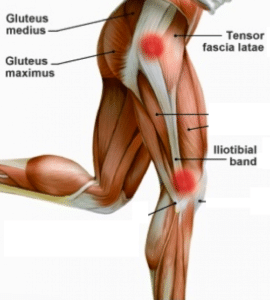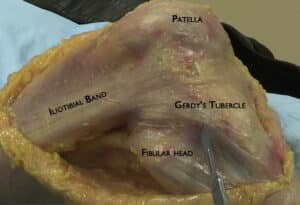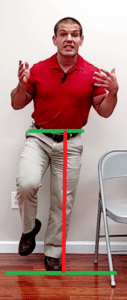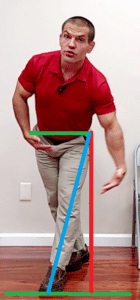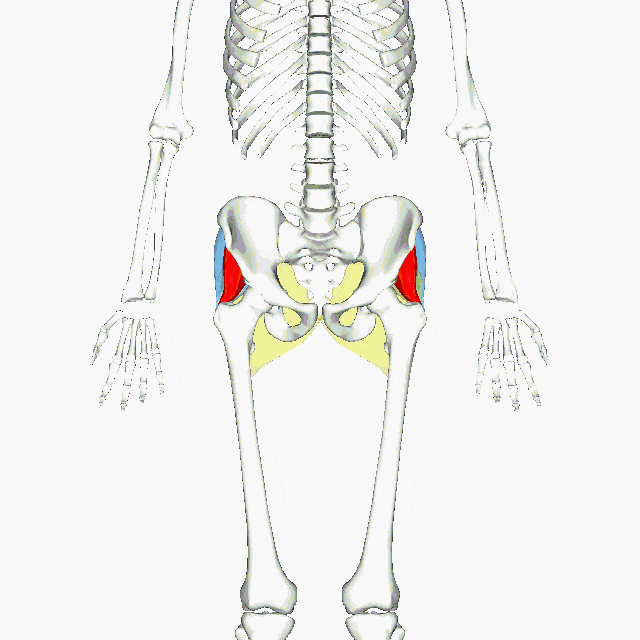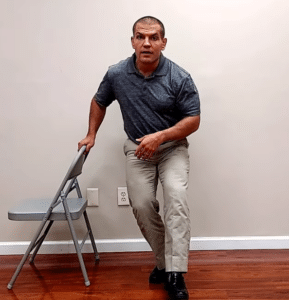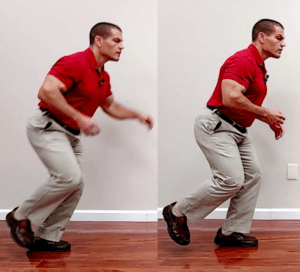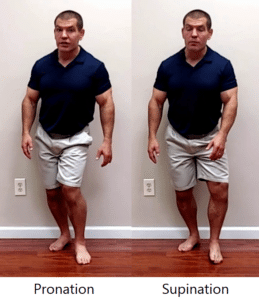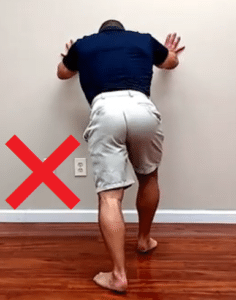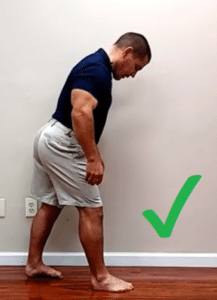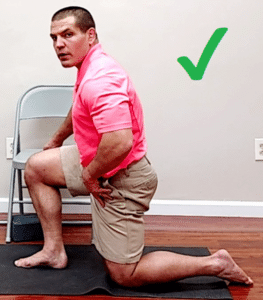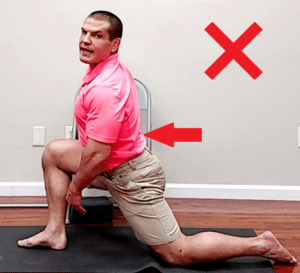Do You Outer Knee Pain From IT Band Syndrome?
Watch the video to learn 7 exercises to stop knee pain from IT band syndrome so that you can get back to the activities that you enjoy as quickly as possible.
Table of Contents:
- What Causes Knee Pain From IT band Syndrome?
- Knee Pain From IT Band Syndrome Treatment
- Strengthening Exercises For Knee Pain From IT Band Syndrome
- Exercise 1: Balancing on One Leg
- Exercise 2: Single Leg Mini-Squats
- Exercise 3: Sequential Hops
- Stretches For IT Band Syndrome
- Exercise 4: Resetting Knee Joint Alignment
- Exercise 5: Calf Stretch
- Exercise 6: Glute and Calf Strengthening For Running
- Exercise 7: Tensor Fascia Latae and Quadriceps Stretch
- Can I Keep Exercising With IT Band Syndrome?
- Do I Have To Stop Running If I Have IT Band Syndrome?
- Conclusion
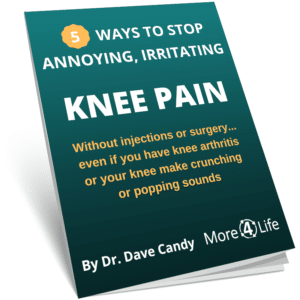
What Causes Knee Pain From IT band Syndrome?
Your IT band, or iliotibial band, runs from your pelvis (ilium) down to your lower leg bone (tibia).
Initially, it was believed that IT band syndrome was caused by the IT band moving back and forth over the knee during exercises that require repetitive bending and straightening of the knee.
This was thought to create friction as the IT band rubbed over the outer side of the knee joint.
However, newer research has shown that the IT band is firmly attached to your thigh bone (femur) and doesn't move back and forth.
Daggett M, et al. Arthroscopy Techniques. Licensed via Creative Commons.
Therefore, IT band syndrome is caused by compression on the fat pad between the IT band and your femur rather than friction of the IT band itself.
Furthermore, as you can see from the image, the IT band is made of very thick collagen fibers.
Therefore, you can't stretch your IT band.
Even if you could stretch your IT band, you wouldn't want to.
The IT band essentially serves as a tendon to transfer force from your hip muscles to your leg. Tendons were NOT designed to stretch.
If you stretch a tendon, you make it insufficient at performing it's purpose, which is to transfer force.
So if you don't want to stretch your IT band, what is the proper treatment for IT band syndrome?
Knee Pain From IT Band Syndrome Treatment
Since the IT band is a fixed length, rather than focusing treatment on trying to lengthen it, instead focus on shortening the distance that that IT band needs to travel.
If you remember from geometry, the shortest distance between 2 parallel lines is the perpendicular line between them.
So when you're walking or running, your leg should form a perpendicular line between the ground and your pelvis.
If your knee goes inward too much (hip adduction), you're increasing the distance that the IT band has to span.
Since the IT band can't stretch, it just compresses up against the femur. This in turn can irritate the fat underlying fat pad.
How then do you keep your knee from going inward too much when you walk or run?
Think "strength before length".
Strengthening Exercises For Knee Pain From IT Band Syndrome
The key to treating IT band syndrome is strengthening your gluteus medius and gluteus minimus muscles.
These are hip abductor muscles, meaning they pull your leg away from midline.
They prevent the hip adduction movement that causes IT band syndrome.
Your tensor fascia latae is also a hip abductor, but it pulls through the IT band. As the name implies, it "tenses" the "fascia latae" (another name for the IT band).
Conversely, your gluteus medius and gluteus minimus attach directly to the greater trochanter of the femur.
BodyParts3D/Anatomography, CC BY-SA 2.1 JP, via Wikimedia Commons
Therefore, they can abduct the hip without tensing the IT band.
When these muscles are weak, the tensor fascia latae takes over as the primary hip abductor. However, it's rarely strong enough on it's own to prevent hip adduction, especially when running.
Therefore it tenses the IT band, but at the same time, the IT band also gets pulled tight across the hip and knee joints. This can create IT band hip pain or knee pain.
Here's how to stengthen your gluteus medius and gluteus minimus to prevent knee pain from IT band syndrome.
IT Band Syndrome Exercise 1: Balancing on One Leg
Begin with basic balance. Stand on one leg, ensuring your knee doesn't cave inward. Make sure your pelvis remains level.
If needed, hold on to a stationary object for support initially.
IT Band Syndrome Exercise 2: Single Leg Mini-Squats
Progress to mini-squats on one leg.
Maintain a level pelvis and practice gentle knee bending while balancing.
IT Band Syndrome Exercise 3: Sequential Hops
For people hoping get back to running, you need to be able to absorb shock from landing on one leg over and over again.
Doing short hops help strengthen your gluteal muscles while improving balance when landing on one leg.
Note that it takes a minimum of 6-8 weeks to build muscle mass. Therefore, you may not see an immediate improvement in your knee pain from your strengthening exercises.
However, they're the most important kind of exercise for preventing IT band syndrome from coming back in the long term.
Conversely, stretching exercises often help relieve pain fast.
But if your IT band can't stretch what kind of stretching exercises can you do?
IT Band Syndrome Exercise 4: Resetting Knee Joint Alignment
Excessive hip adduction and internal rotation can also create a joint dysfuction between the upper leg bone (femur) and lower leg bone (tibia).
This can cause outer knee pain that can be mistaken for IT band syndrome.
To fix this, you can do a joint mobilization to re-set the joint alignment.
Cross the ankle of your painful leg over the knee of the opposite leg.
Then push your femur away from you with one hand while pulling the tibia toward you with the opposite hand. This will be a small motion.
Gentle push and release repeating for approximately 1 minute.
IT Band Syndrome Exercise 5: Calf Stretch
Another stretching exercise you may not think about when you have IT band syndrome is stretching your calves.
If you don't have good flexibility in your calves when you go to take a step - whether you're walking or whether you're running - your body has to find some way around getting over the top of your foot.
If you don't have the flexibility in your calves to get straight over the top of the foot, your body can get around that by doing a motion known as pronation.
But pronation causes your knee to come inwards, and that can cause knee pain from IT band syndrome.
To stretch your calves, one easy way to do that is standing facing towards a wall.
Put your arms up on the wall. Have your feet pointed towards the wall with one leg in front and one leg in back. Learn toward the wall keeping your heel flat on the floor.
Additionally, don't allow your foot to turn ot or flatten or pronate when stretching.
Make sure to keep your arch lifted to avoid pronating your foot.
If you allow your foot to pronate when you're stretching, you're probably going to do the same thing when you're walking and when you're running as well.
Hold the stretch for 60 to 90 seconds.
IT Band Syndrome Exercise 6: Glute and Calf Strengthening For Running
While you're up against the wall, there is another strengthening exercise that's helpful if you want to get back to running.
It helps strengthen your glutes and your calves, both of which you need to push off when you're running.
You also use those muscles to a lesser extent when walking, so its good for people who have IT band pain from walking as well.
To do exercise put your hands on the wall above your head.
Go up on your toes leaning into the wall. This activates both your calves and your glutes.
Bring your opposite knee up as high as you can.
Hold for 10 seconds then to the opposite side. Repeat for 10 repetitions.
IT Band Syndrome Exercise 7: Tensor Fascia Latae and Quadriceps Stretch
People commonly advocate stretching the tensor fascia latae (TFL) for IT band syndrome.
This makes sense since your tensor fascia latae CAN be stretched an your IT band can't.
It's less important than strengthening your glutes though. No matter how often you stretch your TFL, if your glutes are weak, the TFL is going to get stiff again from compensating for the glutes.
That being said, stretching your TFL can be helpful if you have IT band syndrome.
When you stretch your TFL, it also stretches your rectus femoris (one of your quad muscles).
To stretch your TFL start out kneeling in a lunge position with the sore knee on the floor.
Roll your pelvis underneath of you and then push your pelvis forward until you feel a stretch in the front of your hip and thigh.
Don't allow your lower back to arch.
To further stretch the tensor fascia latae, push your hip slightly out to the side.
Can I Keep Exercising With IT Band Syndrome?
Lastly you might wonder if you can still exercise with IT band syndrome.
The answer is:
You can and you should keep exercising if you have IT band syndrome.
Again, IT band syndrome is primarily due to muscle weakness. And if you stop exercising, then your muscles just get weakr.
Sure, resting WILL get rid of your pain.
However, as soon as you get back your previous exercise level, your pain will likely be just as bad or worse.
The key factor lies in what kind and how much exercise?
You should not exercise through pain if you have IT band syndrome
Adjust your training intensity and volume to levels at which you can exercise without pain.
Consider cross-training to maintain your fitness while working on the strengthening exercises above.
Now for the question that most runners REALLY care about:
Do I Have To Stop Running If I Have IT Band Syndrome?
Most runners can continue running, but you will probably have to cut back your mileage temporarily.
Find a distance that you can run BEFORE you start having pain. Then gradually build up your mileage by about 10% per week as pain allows.
However, if you have pain while just walking, then you may have to take some time. off.
Changing your running technique can help
In addition, taking shorter, quicker steps can help minimize the ground reaction force when running. Using a cadence of 170 to 180 steps per minute is ideal for most people.
Conclusion
In summary, knee pain from IT band syndrome doesn't have to keep you from being active. Focus on "strength before length" with your exercises focusing on strengthening your glutes. Doing self knee mobilizations, calf stretches, and TFL stretches can also help.
You can and should keep exercising, but keep the intensity and training volume to a painfree level. Consider cross-training while you're recovering. Finally, when you do get back to running (if that's a goal of yours), take shorter quicker steps and ramp up your mileage slowly.
Need More Help For Knee Pain?
Tap the button below to request a Request an Appointment with one of our knee pain specialists.
Here are some other posts about how to relieve knee pain that you might enjoy:
Should I Use A Foam Roller For IT Band Syndrome?
2 Amazing Tips To Stop Pain On Outside Of Knee
How To Prevent Knee Pain When Running Downhill



